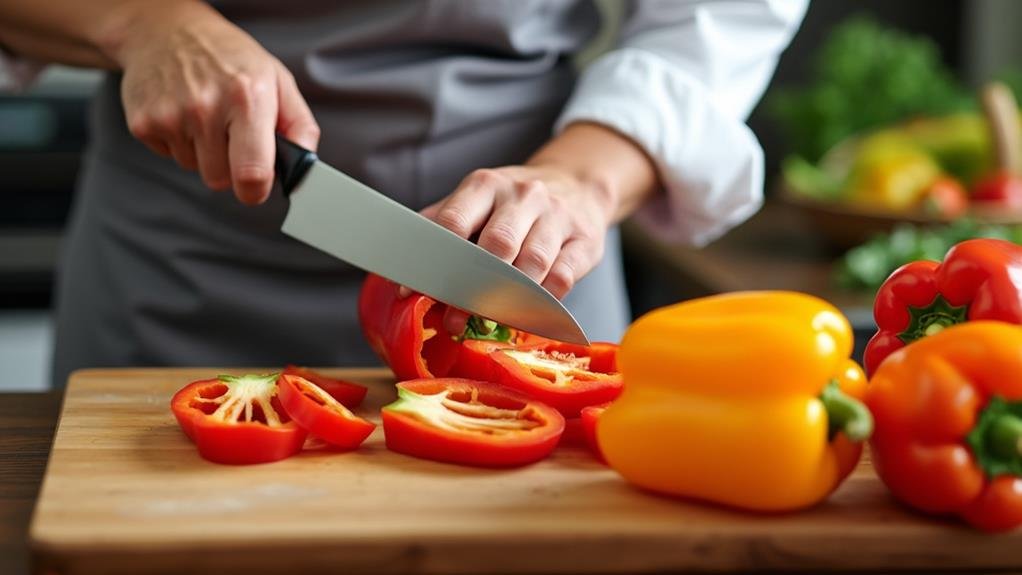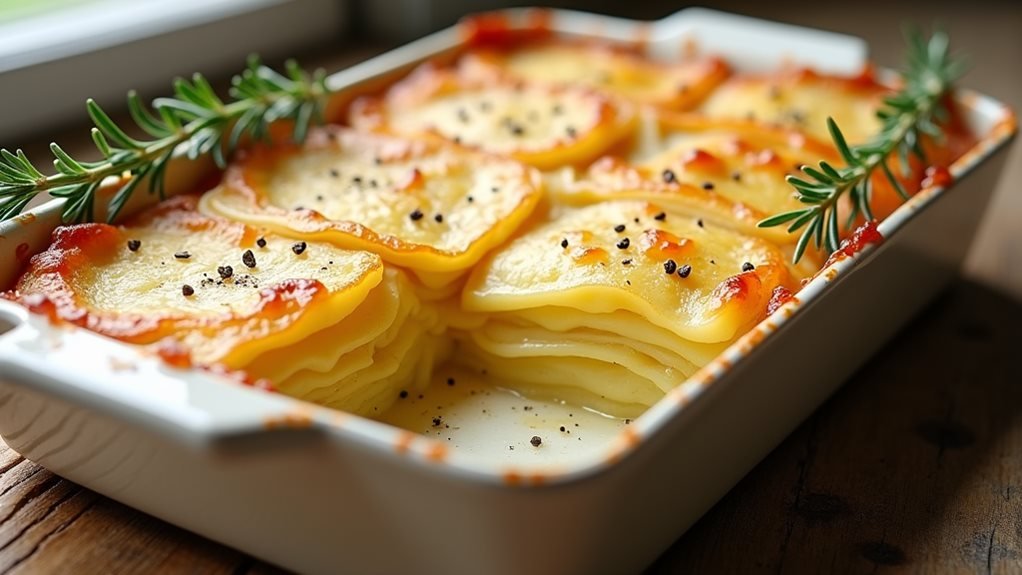To chop herbs like a pro, follow Gordon Ramsay's Three-Finger Rule. This method boosts your control and precision, reducing bruising of delicate herbs and enhancing their flavor and presentation. Place your three fingers in a protective claw over the herbs while keeping your thumb anchored for stability. Utilize a sharp chef's knife for precise cuts that won't crush the herbs, which can result in bitterness. Don't forget to layer basil leaves or shave cilantro for efficiency, and adjust your pace based on the herb variety. Mastering these skills will refine your culinary finesse, and there's more to investigate that can further enrich your techniques.
Benefits of Ramsay's Three-Finger Trick
Gordon Ramsay's three-finger technique offers numerous advantages when chopping herbs. This approach positions your fingers to enhance control and precision during the chopping process. By following the three-finger guideline, you minimize bruising of delicate herbs, which is essential for maintaining their rich flavors and essential oils. Additionally, this method proves especially useful when tackling tear-inducing vegetables like onions, as it encourages safer, more controlled cutting. With your fingers securing the herbs, your knife can perform effectively, resulting in clean cuts instead of mashing or over-chopping the greens.
Moreover, to further enhance your chopping experience, consider effective onion-cutting strategies that help alleviate irritation while preparing meals. This technique significantly reduces the chances of accidental cuts, keeping your fingers safeguarded from the blade. As you practice, you'll achieve uniform cuts, improving both the visual appeal of your dishes and preserving the integrity of the herbs. Embracing Ramsay's method fosters a relaxed and confident approach to herb preparation. In the culinary world, where creativity is vital, Ramsay's three-finger rule equips you with the skills to chop herbs like a professional, elevating your cooking journey while maximizing the flavors of your fresh ingredients.
Importance of Proper Cutting Techniques

Utilizing precise cutting techniques greatly influences the quality of your culinary creations. When you cut basil or cilantro accurately, you enhance their visual appeal while preserving their vibrant flavors and nutritional benefits. By maintaining the structure and integrity of these herbs, you prevent the bitterness that can result from bruising or excessive chopping. Choosing the right cutting board, such as a John Boos wooden board or a plastic one, can also affect your results, as wood boards help maintain knife sharpness and are gentler on delicate herbs. Strong kitchen skills ensure that each herb contributes its distinct essence to your meals, elevating their appeal.
Moreover, effective cutting methods reduce unnecessary pressure on fragile herbs. This aspect is crucial since herbs often serve as key components of a dish, adding brightness and freshness. When you respect their composition, you'll notice an enhancement in presentation. A beautifully prepared plate not only tastes better but also looks more inviting.
Practicing proper techniques allows you to embrace creativity in the kitchen. You gain confidence in your abilities while developing a deeper understanding of how each herb functions. As you refine your cutting skills, you'll find that your dishes stand out, impressing family and friends. Ultimately, mastering these techniques can unlock a new level of culinary artistry.
Tips for Cutting Different Herbs

When cutting various herbs, using the right techniques can greatly enhance flavor and presentation. For basil, stack the leaves by size and cut them in small batches to preserve their vibrant taste without bruising. With cilantro, scrape the leaves from the stalks before chopping; this keeps the fresh flavor intact. For chives, employ a back-slicing method, making sure not to lift the blade; this provides a clean cut without crushing the herb. Such attention to detail reflects the culinary mastery exhibited in Gordon Ramsay's cooking classes.
For parsley, remove the tough stems before chopping to enhance texture and taste. When dealing with mint, stack the leaves and slice in a gentle, swift motion; this technique preserves the essential oils that contribute to mint's refreshing flavor. Each herb possesses unique qualities, and tailoring your method accordingly can significantly elevate your culinary outcomes. By adhering to these guidelines, you'll not only improve the visual appeal of your dishes but also enhance their flavor profiles. Remember, the aim is to keep your herbs fresh and vibrant, ensuring your meals are as delicious as they are beautiful. Happy chopping!
Considerations for Using the Technique

When cutting fresh herbs, using Ramsay's three-finger technique requires thoughtful consideration to maximize its benefits. First, ensure your chef's knife is razor-sharp. A dull blade can crush delicate herbs, diminishing their flavor and fragrance. Position your fingers precisely to maintain control during the cutting process. This technique provides accuracy, but adjust your grip based on the herb's type and texture. For instance, freshly chopped parsley or thyme can enhance dishes, such as Gordon Ramsay's cauliflower steaks, showcasing the vibrant tastes that herbs offer.
Handle herbs gently; they are fragile, and too much pressure can cause bruising. When slicing softer herbs like basil or mint, slow your cutting speed to preserve their quality. For heartier herbs like rosemary, you can increase your pace but always prioritize delicacy. Remember that some herbs, such as cilantro, may require a distinct method, so stay adaptable in your approach. By concentrating on these factors, you will not only elevate your dish's visual presentation but also retain the nutritional benefits and flavors of the herbs. Embrace the opportunity to innovate while respecting each herb's unique characteristics, and watch your herb-cutting abilities improve.
Enhancing Your Herb Cutting Skills

To enhance your herb chopping skills, watching cooking demonstrations can offer insightful visual instruction that helps you master the subtleties of various methods. Observing skilled culinary experts will teach you how to handle fresh ingredients delicately and accurately, which is essential for preserving their taste and visual appeal. Furthermore, understanding the proper utensils and techniques can elevate your chopping efficiency, similar to the precision required in baking perfect brownies.
Here are three strategies to improve your herb chopping abilities:
- Practice Frequently: The more you slice herbs, the more proficient you'll become with your technique. Regular practice allows you to sharpen your movements and build muscle memory.
- Explore Different Herbs: Experiment with a range of herbs to appreciate their distinct textures and flavors. Each variety may require a specific method—basil is fragile, while thyme is more robust.
- Request Guidance: Don't hesitate to seek advice from seasoned chefs. Constructive feedback can help you pinpoint areas for enhancement and boost your self-assurance.







